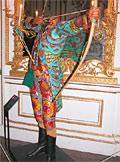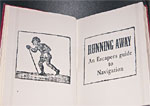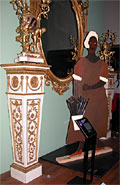You are here: Reports » Phase 2: exhibitions » Art » 'Uncomfortable Truths'...
'Uncomfortable truths': the intervention of the past at the Victoria and Albert
Dr. Michael White, University of York
Dr. Michael White examines the exhibition at the Victoria and Albert Museum which uses the responses of contemporary artists to the issues of enslavement as means of addressing the history and legacy of slavery. Combining powerful, arresting pieces and juxtaposing these with the museum's permanent collections, the exhibition reveals an intriguing means of confrontation with a painful, traumatic past.
Marking the Abolition
This exhibition, featuring works by eleven contemporary artists, was dispersed throughout the permanent collections of the Victoria and Albert Museum. Proposed as 'interventions', the works were intended to address the legacy of the slave trade and its connections to the museum. The bicentenary of the 1807 abolition of the slave trade formed the pretext for the exhibition, although the title, 'Uncomfortable Truths', made clear from the start that there would be very little self-congratulation and the issue of abolition itself was not to be a key theme. In fact, the museum deployed contemporary art very specifically, to stress both that the slave trade should not be considered only as a shameful episode in the nation's past, but as a practice that has shaped contemporary Britain. While some works were specially commissioned for the exhibition, all the artists represented have over previously examined displacement, memory, cultural identity and racism in their art. The international nature of the pieces, produced in Africa, Europe and North and South America, also revealed a desire not to reduce the history of the slave trade to a singular narrative of one country's involvement. The exhibition 'trail' was heavily orientated around the British Galleries of the museum but it was the transatlantic slave trade that was the focus.
Intervention
Two works by Yinka Shonibare and Fred Wilson strategically positioned in the Norfolk House Music Room, the reconstituted interior of a house on St James Square, a former royal residence built for the Duke of Norfolk in the early eighteenth century, brought to the fore how we might question the interconnections between the slave trade and our perception of national cultural heritage. Yinka Shonibare's 'Sir Foster Cunliffe, Playing' (2007) figured the grandson of a prominent Liverpool slave merchant as a headless archer dressed in period style, although his clothes have been tailored from brightly coloured batik cloth.

Detail from 'Sir Foster Cunliffe, Playing'
Photo: Helen Weinstein
Copyright: Yinka Shonibare
Courtesy: Victoria and Albert Museum, London
Larger image (56KB)
While we now consider batik a characteristic West African product, it was originally a British export to Africa, derived from the Dutch appropriation of Indonesian printing techniques. It became extremely popular in Africa and favoured over traditional costume as a sign of social prestige. By dressing Cunliffe this way, Shonibare is pointing to the intertwining of the constructions of 'African' and 'British' identities through exchange; Britain traded textiles for slaves many of whom were used to produce cotton which was then brought back to Britain to supply the textile industry.

Detail from 'Regina Atra'
Photo: Helen Weinstein
Copyright: Fred Wilson,
Courtesy: Victoria and Albert Museum, London
Larger image (42KB)
Positioned close by was Fred Wilson's 'Regina Atra' (2006), a copy of a diadem made for the coronation of George IV, often worn by Queen Victoria, but perhaps most familiar from the image of the younger Elizabeth II found on banknotes, coins and stamps, only this time constructed from black diamonds. More than a simple reversal of white and black as qualities of aesthetic attractiveness, or even a comment on the exploitation of valuable natural resources by colonial powers, the object provokes a consideration of the symbolic order the slave trade was founded on. Although jarring with our expectations of what objects in the V&A ought to look like, both of these items played off the established holdings of the museum, such as its extensive fashion and metalwork collections.
Trails of the past
Running parallel to the contemporary art exhibition was another 'trail', 'Uncomfortable Truths: Traces of the Trade' (20 February-31 December 2007), which singled out some twenty-five items from the permanent collection for selective reinterpretation in connection to the slave trade. These included items made to store goods such as sugar, coffee and tobacco, those with representations of black servants or imagery used to promote the cause of abolition and a few African objects made of precious metals. If the museum is poor in terms of objects that obviously represent slavery, this modest display demonstrated how easily one might connect thousands of its objects to the economics of the slave trade. As with Shonibare and Wilson's works, the discomfort we experience in considering these connections is in proportion to the enjoyment we receive from looking at these exquisite things.
Other contemporary interventions were less related to the museum's collections and were positioned in some of the intermediary spaces of the museum. Perhaps given the most prominent spot was Romuald Hazoumé's 'Dan-Ayido-Houedo/Arc-en-Ciel, Symbole de Perpetuité' (2006-7), a snake biting its tail made from the tops of a large number of plastic jerry cans. Again, trade was the predominant theme, in this case the oil business. Despite West Africa's rich resources, local corruption and the domination of the oil market by multinational corporations have prevented ordinary people from benefiting from this wealth. The cans, which have physiognomic characteristics, represent modern day Africans disempowered by the global petrol market. Another artist given a prominent spot, El Anatsui, has also worked a lot with 'found objects' resonant of the exchange between Africans and Europeans, such as tops from gin bottles. On this occasion, his driftwood sculpture, 'Akua's Surviving Children' (1996), had a more human dimension. Placed on the landing of the main staircase of the museum in front of mosaics representing artists such as Holbein and Raphael, the standing pieces of driftwood took on the appearance of figures reclaimed from the horror of transportation.
The closest the exhibition came to issues of commemoration was with the display of Julien Sinzogan's 'Gates of Return', a large, multi-panelled painting commissioned for display in the main foyer. Overlaid on the depiction of the departure of enslaved Africans from the slave forts of West Africa, is their homecoming in the form of ancestor spirits, but this arrival can only occur if they are properly remembered. As Sinzogan wrote for an accompanying label, 'We need a place on earth, in America, in England, in France, in Spain, in Portugal or in Africa where we can meet History, set up memory and where we can talk to the spirits of slaves and pray for them, because there are three ways to die: lost memory, false memory and real death. We need such a place, we need a Gate of Return.'
Museums are places where memory is constructed, but there was some ambiguity in the exhibition regarding Sinzogan's appeal for the restitution of lost memories or correction of false memories as a means of coming to terms with the past. Christine Meisner's 'Recovery of an Image: A Video-Tale' (2005), tells in the first person the story of the return of a modern-day enslaved African from Brazil to Nigeria. The narrator, Joao Esa de Rocha, describes how, after thirty years away, he was unable to relocate his family, his friends or the community he was taken from. His forced removal and transportation had effectively transformed his identity and he eventually returns to South America. As we consider the loss experienced by de Rocha, left only with memories of his African home, we realise how significant recollection is in the formation of new identities not simply in the preservation of old ones. We are not encouraged to doubt de Rocha but to consider how much of his inability to match the reality of Nigeria to his memory of it is the product of his experience of displacement.

Detail from 'Lost Vitrines'
Photo: Helen Weinstein
Copyright: Keith Piper,
Courtesy: Victoria and Albert Museum, London
Larger image (32KB)
An even more radical questioning of the preservation the past was the intervention by Keith Piper, whose 'Lost Vitrines' contained objects that could be mistaken for historical documents, such as the book 'The Coloureds' Codex. An Overseer's Guide to Comparative Complexion' and 'Miss Mary's Micro-Resistance Tool Kit', a box containing bottles and a manual instructing slaves on how to collect various bodily substances and use them surreptitiously against their masters. The latter may be less plausible than the former as an actual historical object but the point Piper made concerns the museological narrative as a convenient fiction with which an artist can interfere. The implausibility of the micro-resistance tool kit is less to do with whether such an object could have existed or not but the way it fits our understanding of the museum collection. It grants a form of agency to enslaved people that challenges the ways they are normally represented.

Detail from 'Naming the Money'
Photo: Helen Weinstein
Copyright: Lubaina Himid
Courtesy: Victoria and Albert Museum, London
Larger image (45KB)
Very little of 'Uncomfortable Truths' conformed to the traditional iconography of the slave trade, such as images of shackles, brutality or even the Middle Passage. It carefully avoided the pitfalls of aestheticising white violence against black people. Many of the exhibits were highly attractive visually but also very subtle. Lubaina Himid's 'Naming the Money' (2004), a series of sixteen cut out figures of black slave-servants, mimicked objects that can still occasionally be found in European houses as echoes of times when such figures were real people.

Detail from 'Naming the Money'
Photo: Helen Weinstein
Copyright: Lubaina Himid
Courtesy: Victoria and Albert Museum, London
Larger image (19KB)
Representing skilled individuals such as musicians, herbalists and cooks, each came with a balance sheet giving a name, an acquired name, previous profession, current profession, income and expenditure (in each case $0.00). Not only did the figures obviously mark the treatment of people as goods, they also made visible and identified the contribution of enslaved Africans to European culture. Remarkably each balance sheet ended on a positive note, listing one possession the individual owns, even if it be quite abstract, such as 'But I have their thanks.' Reconciling oneself to the pathos of a statement such as this is about as uncomfortable as you can get.
Responses
'Uncomfortable Truths' provokes a variety of questions regarding the manner in which we can confront the past with the present. If you wish to contribute your opinion to this article or the exhibition email the 1807 Commemorated project team - arch-1807@york.ac.uk
